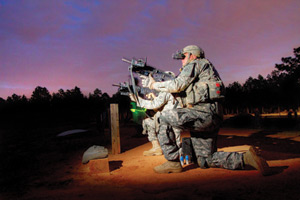The Military's Next Buffer Zone

December 20, 2010
BY Luke Geiver
North Carolina's Fort Bragg is big, roughly 165,000 acres, but while the military installation's main theater of training happens several thousand feet in the air, the Fort needs to expand. But while it cannot expand in acreage, the dilemma might present an opportunity for biodiesel. The institution (the size of an entire county), acts as a major economic driver, according to Jon Parsons, executive director for Sustainable Sandhills, a nonprofit organization founded by Fort Bragg to work with the surrounding communities. Because of the impact, Parson says, "It is a very attractive place to live." That apparently is a problem, especially to the home of the 82nd Airborne Division.
"At Fort Bragg we had a drop zone that was right on our boundary," says Julia Love, sustainable land use planner for the Fort, "and real estate developers in the 1990s built right up to the property line." And, as Love says, you can't have a drop zone on the boundaries with housing only a few hundred yards away. Why? Imagine taking a sip of your morning coffee on a crisp North Carolina morning, watching a soldier or a piece of equipment fall from the sky into your backyard. Love says, "When we were doing drops with soldiers and cargo equipment, we had drops landing in the back yards of houses, and that basically took that drop zone out of use."
Today, with commercial and residential encroachment towards the outside fence, they employ a program developed to deal with this specific problem. The Army Compatible Use Buffers program acts to establish a buffer zone around a military installation to reduce land restrictions and increase the amount of land available for a wide range of military training sessions, including air drops like those performed at Fort Bragg. The program at its best, says Love, acts as a public/private partnership, bringing together local farmers or nature conservatories to utilize and maintain sections on and off the base through agricultural practices that benefit both parties.
Fort Bragg is currently working with a farmer to maintain a 100-acre Coastal Bermuda hay field. As a result, the farmer will get paid and the base can use the hay. "We do not have any program currently where any of that land is in production for biodiesel," Love says, "but it would certainly be a good fit for that program in the future." Typically the crops that grow well in the area are tobacco and soybeans.
We know the U.S. continues the push for fossil fuel independence, but could we actually grow an energy crop and produce a biofuel at our military installations? If it seems improbable, ask a few homeowners living outside Fort Bragg about the probability of a paratrooper showing up in the backyard.
"At Fort Bragg we had a drop zone that was right on our boundary," says Julia Love, sustainable land use planner for the Fort, "and real estate developers in the 1990s built right up to the property line." And, as Love says, you can't have a drop zone on the boundaries with housing only a few hundred yards away. Why? Imagine taking a sip of your morning coffee on a crisp North Carolina morning, watching a soldier or a piece of equipment fall from the sky into your backyard. Love says, "When we were doing drops with soldiers and cargo equipment, we had drops landing in the back yards of houses, and that basically took that drop zone out of use."
Today, with commercial and residential encroachment towards the outside fence, they employ a program developed to deal with this specific problem. The Army Compatible Use Buffers program acts to establish a buffer zone around a military installation to reduce land restrictions and increase the amount of land available for a wide range of military training sessions, including air drops like those performed at Fort Bragg. The program at its best, says Love, acts as a public/private partnership, bringing together local farmers or nature conservatories to utilize and maintain sections on and off the base through agricultural practices that benefit both parties.
Fort Bragg is currently working with a farmer to maintain a 100-acre Coastal Bermuda hay field. As a result, the farmer will get paid and the base can use the hay. "We do not have any program currently where any of that land is in production for biodiesel," Love says, "but it would certainly be a good fit for that program in the future." Typically the crops that grow well in the area are tobacco and soybeans.
We know the U.S. continues the push for fossil fuel independence, but could we actually grow an energy crop and produce a biofuel at our military installations? If it seems improbable, ask a few homeowners living outside Fort Bragg about the probability of a paratrooper showing up in the backyard.
Advertisement
Advertisement
Advertisement
Advertisement
Upcoming Events





